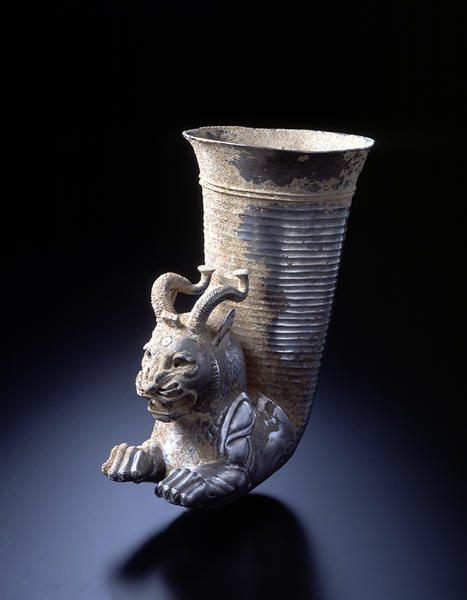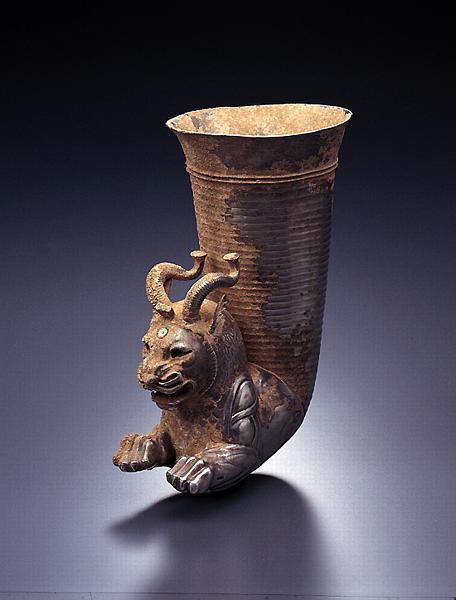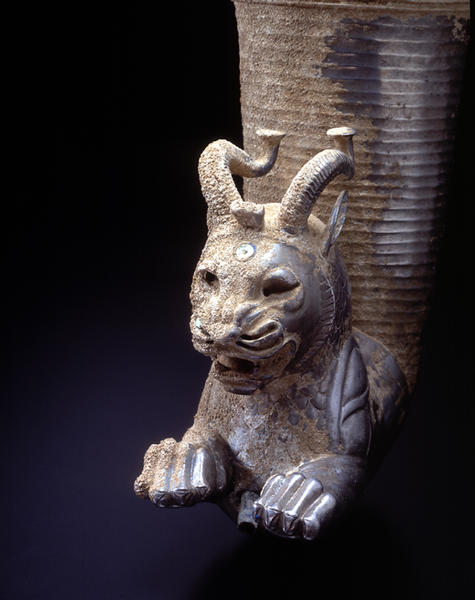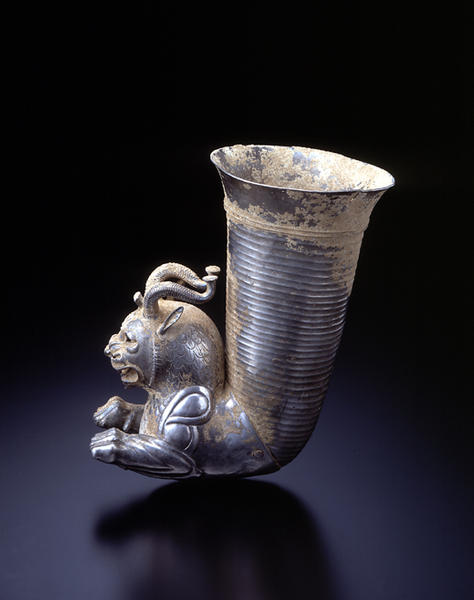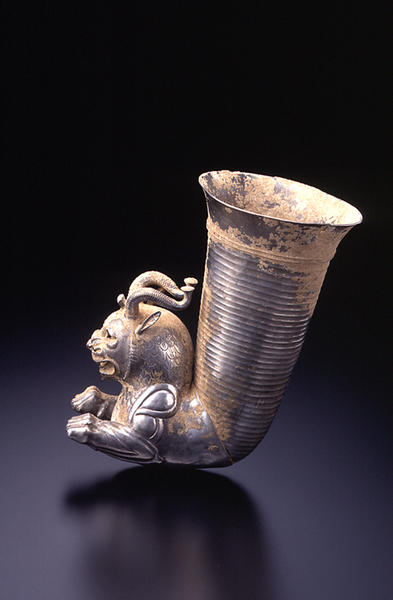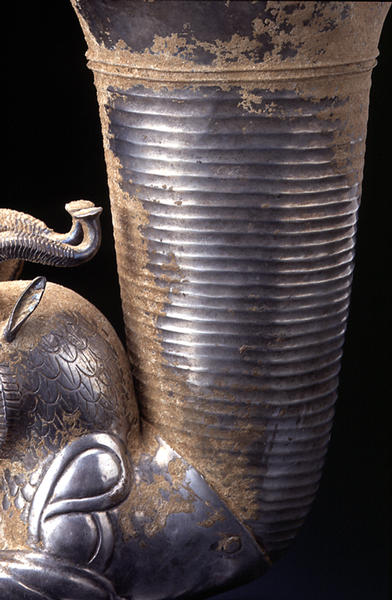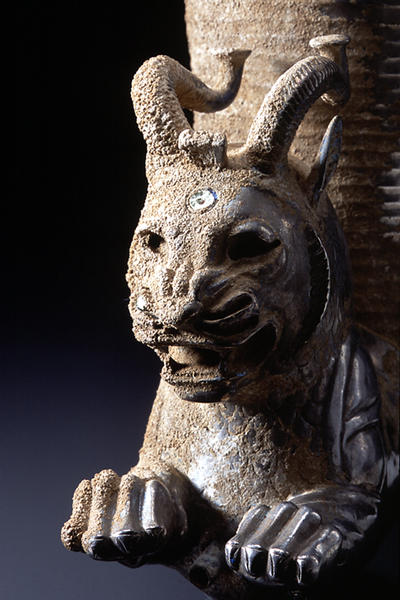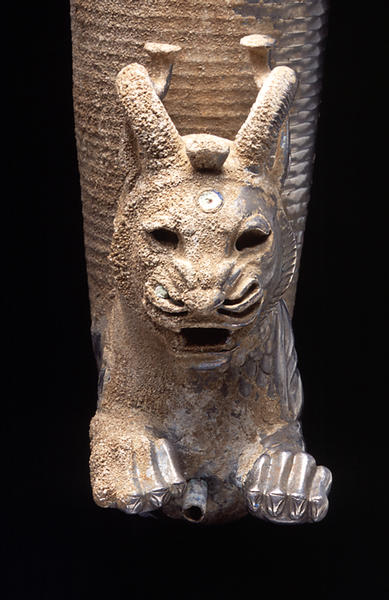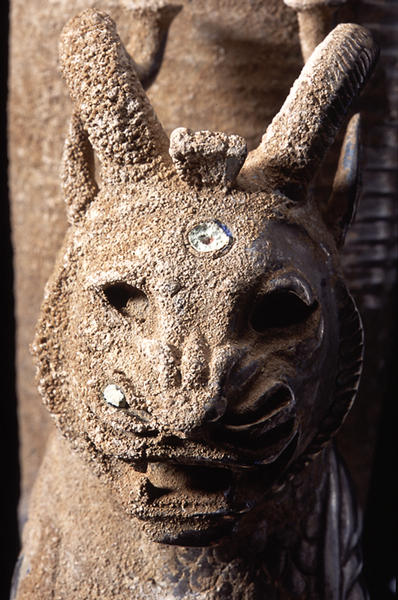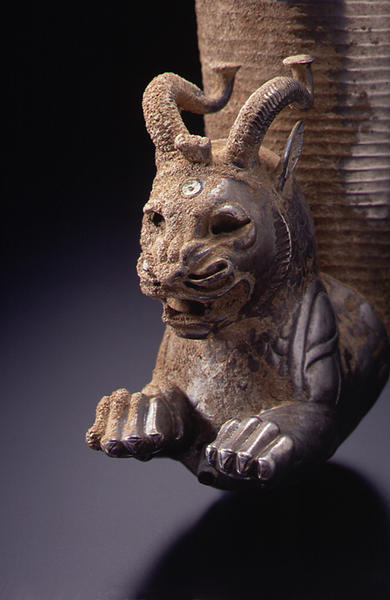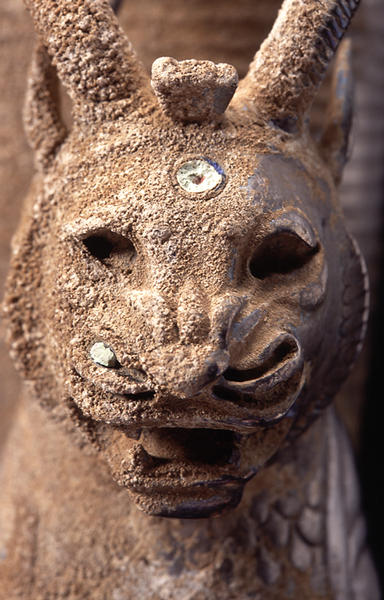ライオングリフィン形リュトン
- アケメネス朝ペルシア
- 紀元前4世紀
- 銀、ガラスの練物
- H-17.5 D-10 W-5.2
このリュトンは湾曲する角をつけ耳が直立するライオン様の猛獣といった空想の合成獣をその前半部につけているが、おそらく羽を省略したライオングリフィンを表現したものであろう。その額には精緻な円形の貴石の象嵌がなされているが、これが仏教の白毫にもながるウルナを意味するものであるとしたら、それはこの器の東方起源を物語るものであろう。
リュトンは飲酒用あるいは液体を注ぐための容器で、アケメネス朝ペルシアではこの作品のように注口部が動物の前半身をかたどったものが流行した。ライオンの特徴を多く備えた空想の怪獣ライオン・グリフィンを表現している。額中央には円形の象嵌が施され、皺の一部にも象嵌材が残っている。風化が甚だしいが、いずれもガラスのようであり、額には青色のガラスが観察できる。色鮮やかに飾られていたのかもしれない。貴金属製のリュトンはアケメネス朝ペルシアの奢侈容器として極めて重要なものであり、このような素晴らしい作品が知られているが、図版59のようにガラスで作られた例もある。
ペルシャのはじまり
紀元前7世紀末から6世紀初頭にかけて、メソポタミアの最大の帝国アッシリアとその最大のライバル、ウラルトゥは、あいついで北西イランのメディアと南メソポタミアのバビロニアの同盟勢力のもとに降り、更にそのイラン系メディアは西アジア世界を初めて統一する大帝国となりました。
イラン系メディアは程なく東南イランの大きい同盟勢力であったイラン系ペルシャに取って替わられ、アケメネス朝ペルシャが立ちました。
紀元前8-7世紀のこの混沌とした時代を通じて、これらメディア、ペルシャなどのイラン民族は好戦的な神々を仰ぐ伝統的な宗教から、秩序と正義そして平和をもたらす世界の救世主をあおぐゾロアスター教に急速に転向して行きました。
彼らは世界を善悪の対立としてとらえ、最終的に善の勝利としての審判が到来するとする終末論から、現実の世界の変容を求めました。
それは絶対善の創造神アフラ・マズダーのもとに統一された世界、アフラ・マズダーから多くの者の中の唯一の王となされた王を頂く巨大帝国をつくりあげることであったと言えます。
Mary Boyce/ A History of Zoroastrianism/ Leiden I- 1996-172ff. , II- 1982- 105 ff.
ペンダント付トルク
宝飾品ー腕輪、トルク、イヤリング、首飾、指輪印章他
有翼獣文様鉢
鴨装飾ブレスレット
鴨装飾ブレスレット
馬形リュトン
帝王闘争文様鉢
獅子頭形杯
二頭の馬浮彫
メディア人従者浮彫
帝都建設の銘文
――そして此は私がスサに建てた宮殿。その資材は遠方より齎された。地面を地中の岩盤まで深く掘り下げた。土を取り除くと砂利が敷き詰められ、あるところは40キュビットあるいは20キュビットに達した。宮殿はこの砂利の上に建てられたのである。地中深く掘り、砂利を敷き詰め、泥煉瓦を作る―――――これら全ての作業はバビロニア人が行った。 杉材はレバノンの山からアッシリア人がバビロンまで運び、カリア人イオニア人がスサまで運んだ。シッソ材はガンダーラとカルマニアから、ラピス・ラズリ、カーネリアンの準貴石はソグディアナから。トルコ石はホラズム、銀とエボニー材はエジプト、壁の装飾はイオニア、象牙はエチオピア(クシュ)やインドそしてアラコジア、石柱はエラムのアビラドゥから運ばれた。石職人はイオニア人、リディア人。金細工師、象嵌細工師はメディア人、エジプト人。バビロニア人は煉瓦を焼き、メディア人、エジプト人は壁を装飾した。 このスサにすばらしいものを建てんとし、すばらしいものができた。願わくばアフラマツダの神が私、父ウィスタシュパそして我が同胞をみそなわし賜わんことを。
Walter Hintz/ The Elamite Version of the Record of Darius's Palace at Susa / 1950 Journal of Near Eastern Studies Vol.IX No.1
ペンダント付トルク
宝飾品ー腕輪、トルク、イヤリング、首飾、指輪印章他
有翼獣文様鉢
鴨装飾ブレスレット
鴨装飾ブレスレット
馬形リュトン
帝王闘争文様鉢
獅子頭形杯
有翼山羊装飾ブレスレット
獅子頭装飾ブレスレット
双獅子頭装飾ブレスレット
二頭の馬浮彫
メディア人従者浮彫
Catalogue Entry
The rhyton with an animal protome-a horn for liquids to which the depiction of the forepart of an animal was attached, at a right angle-was a vessel form that came more widely into use in the Near East during the Achaemenid period (about 538-331 B.C.). The protome of this rhyton depicts the forequarters of a fantastic hybrid creature, a leonine beast with curved blunt horns and upright ears, probably meant to represent a wingless lion-griffin. It is shown with open mouth and wrinkled muzzle, snarling, its foreleg muscles tense and claws extended. The body of the beaker is horizontally fluted in typical Achaemenid style. A finely worked chevron ribbing covers the horns of the animal. Raised double-lobed motives define the creature's haunches. Its neck and chest are engraved with an overlapping featherlike pattern. On the neck this pattern has a narrow pointed rib in the center of each individual segment; whereas on the chest the segments are empty.
This extraordinary vessel may be compared with a similar Achaemenid-period silver-gilt rhyton with a griffin protome found in Erzingan, Armenia, and now in the British Museum.1 Several other silver vessel and objects of luxury from the same period found at this site are also in the British Museum's collection, and it is possible that these were the property of a wealthy satrapal court. Other Achaemenid silver objects that accompanied the horned-lion rhyton and are now in the Shumei collection include a rhyton with a calf-protome, two lobed libation bowls, a lidded flask, a ladle with lion ornaments, and a large lobed bowl. The last named bears inscriptions in Old Persian and Late Babylonian which state that it was made for King Artaxerxes. This might refer to any one of three Achaemenid rulers known by that name who reigned in the fifth and fourth centuries B.C. The horned-lion fits well within the tradition of Achaemenid style in sculpture. Its snarling face recalls similar beasts on protome capitals and reliefs at Persepolis; and the double lobed B-shaped patterns on its haunches are likewise found on relief friezes of striding lions in the Hall of a Hundred Columns at the same site.2 At Achaemenid Susa, lions with double-lobed muscle patterns and winged lion-griffins are depicted in glazed brick reliefs; and horned-lion heads are repeated on glazed tile designs.3
Details of the Shumei horned-lion rhyton present us with numerous parallels in Achaemenid decorative arts as well. A magnificent gold rhyton in the Iran Bastan Museum in Teheran has a horizontally fluted beaker fitted to a protome of a snarling lion with large, elegantly curved, separately attached wings.4 A gold rhyton in the Metropolitan Museum of Art has as its protome a similar leonine creature with a crested mane and small engraved wings emanating from B-shaped muscle outlines on its haunches.5 The ibex protome on a silver rhyton also in the Metropolitan Museum has a ribbed pattern on its horns similar to that of our horned-lion.6
One unusual feature of this Shumei rhyton is the elaborately made circular inlay on the lion's brow. If meant as a significant emblem, it may suggest an eastern provenance for the vessel. We find the urna, an auspicious mark, on the brows of both Buddhist and non-Buddhist deities in the imagery of the Kushan Empire, which encompassed Afghanistan in the first three centuries A.D. It is possible that this symbol was already known and utilized in an eastern Iranian environment during the Achaemenid era.7 Although the horned-lion has an animal not a human form, it must have represented a powerful supernatural entity. The most dramatic scenes found at Persepolis show royal figures stabbing an array of rampant, attacking hybrid beasts, a winged lion-griffin among them.8 A similar motif appears on the decoration of an Achaemenid silver bowl in the Museum's collection (fig. 1). It would appear that such fantastic creatures could serve as powerful protectors in some instances, and at other times personify dangerous adversaries of the king.
This vessel was created by hammering, engraving, soldering and riveting together its separately made parts. The upright beaker with its flared rim is attached to the horned-lion protome by five rivets. The lion's forelegs, horns, ears, forehead ornament and spout are soldered to the animal's body. A tube, now missing and probably loose inside the protome, originally connected the beaker to the spout between the legs.
IP
1. Dalton 1964, pp. 42-45, no. 179; see also nos. 180-86.
2. See Ghirshman 1964, figs. 265, 268, 286.
3. See Ghirshman 1964, figs. 191, 193; Harper et al. 1992, pp. 230-31 no. 168.
4. Ghirshman 1964, fig. 290.
5. Ghirshman 1964, fig. 306.
6. Muscarella 1974, no. 155. This vessel was formerly in the Norbert Schimmel collection.
7. For a further investigation of this subject see Tanabe 1985.
8. Ghirshman 1964, figs, 250-53.
